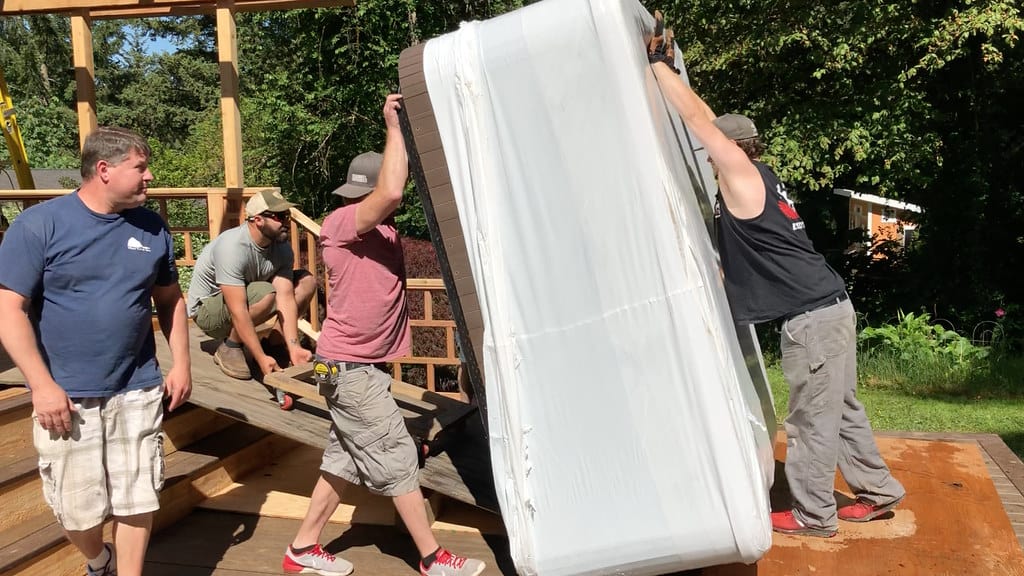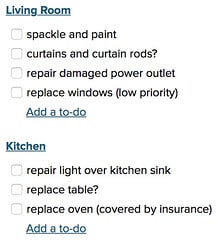The proactive homeowner: How to stay on top of home improvement
Yesterday was an exciting day at the Rothwards household! After three weeks of demolition and construction, we installed our new hot tub.
It took six men an hour of maneuvering before we managed to set the spa into place…but we did it. And we didn't break anything. Now it's a matter of completing the decking and roofing, then Kim and I will be able to enjoy our remodeled outdoor oasis!

We're eager for construction to be over. Since buying our “English cottage” last summer, we've poured tons of money and time into a variety of renovations. It's been a non-stop construction zone.
You see, during the seventeen years the previous owners lived here, they performed very little maintenance and upkeep on the home and property. When we had the place inspected before purchase, the inspector raised a lot of concerns:

The inspection report was so dire that Kim and I almost passed on the purchase.
After we did decide to buy the place, I vowed that I'd be a proactive homeowner. Instead of allowing things to fall into a state of disrepair, I wanted to fix everything that was broken and then stay on top of home improvement in the years to come.
Today I want to share four specific actions I've taken to try to be a proactive homeowner.
Develop a Schedule for Regular Maintenance
A great place to start with home improvement is to find (or create) a regular maintenance schedule. While you'll definitely have projects specific to your own house (about which more in a moment), there are certain chores that ought to be done on a routine basis.
Here in Oregon, for instance, gutters should be cleaned both at the start and the end of the rainy season (late October and late April). Spring is a good time to wash windows, inside and out. It's also time to clean and set up outdoor furniture. During the summer, I like to trim trees and shrubs back from the side of the house. Fall is a good time to inspect the attic and crawlspace.
To create our maintenance schedule, I started with this home maintenance checklist [Google Doc] based on an article from The Art of Manliness. I tweaked the document to fit our needs, adding and removing things specific to our home.
I've also discovered that it's useful to add certain recurring tasks to my digital calendar. (I'm never going to remember to change the furnace filter unless I make an appointment with myself to do so.)
Create a House-Specific To-Do List

I keep our to-do list in Basecamp, a web-based project-management tool that I already use for other projects. (I've heard good things about Asana too, although I've never used it.) You might keep your to-do list in a spreadsheet or even a spiral notebook.
For each room in the house and area of the property, I keep a separate list of tasks that need to be completed. To start, I populated these lists in two ways:
- I went through the pre-purchase inspection report and added every problem the inspector had flagged. Some of the stuff he noted was minor. In these cases, I made sure to mark the task as “low priority”.
- Kim and I made a slow tour of our home and yard in order to catalog other projects we wanted to complete. For example, every room in the house needs new paint. Every corner of the yard needs to be weeded and re-landscaped.
We refer to our to-do list constantly. Whenever we have a free weekend for home maintenance (as we did last weekend…and this coming weekend), we check the list to see which tasks are most pressing and/or most appealing.
Finally — and this is important (if somewhat obvious) — whenever we find a new project that needs to be tackled, we add it to our list. By keeping our home projects to-do list up to date, needed maintenance should never be neglected.
Keep a Home Journal
Before we even moved in to our current home, I started keeping a “home journal” to log everything we learned about the place. Honestly, it's one of the smartest things I've ever done.
I keep this home journal in a Microsoft Word document. (I've uploaded an edited version to Google Docs for you all to look at.) Every time we do major work on the house, I make an entry in the journal. Every time we discover something new about the property, I make a note in the journal.
Here's a typical entry from my home journal:

Each note includes a date and the type of work done, then a narrative description giving more detail. In some cases, I document costs. Most of the time, however, we keep receipts and invoices and other documentation in a dedicated Dropbox folder, which is where the home journal lives too.
This journal is mostly meant for me. From past experience, I know that I'll forget what work we did when, which usually leads to a frustrating search for documentation. With my home journal, I have all of the needed info in one place.
This home journal has a secondary purpose. I want to use it as documentation if/when Kim and I decide to sell this place. I want to be able to show prospective buyers all of the upgrades we made to the house. (Note that this benefit is purely theoretical. When we sold our motorhome recently, we learned that many buyers view work like this as evidence there's something wrong with what you're selling.)
On a similar note, it's smart to perform periodic video tours of your home and property. These are useful not only for you but also in the event of an insured loss, such as robbery or house fire. When shopping for a house, I film every home I tour. After buying and moving into a new place, I do another pass through with the camera. Going forward, I try to do a video tour about once per year.
Build a List of Trusted Contractors
Over the past fifteen years, I've learned that contractors come in all kinds of flavors. Some are cheap. Some are fast. Some do quality work. I've also learned that it's impossible to find a contractor that possesses all three traits. Two of them? Sure. But not all three. (In other words, if a contractor is fast and high-quality, she's going to be expensive.)
When we started looking for homes last Spring, my friend Emma Pattee — who has experience buying and remodeling rental properties — suggested that I start a spreadsheet to list trusted contractors. “My husband and I have done this for a while now,” she told me, “and it really helps. When we find somebody we like to work with (or think we might want to work with in the future), we add them to the spreadsheet. I'll send you our current list, if you'd like.”
Kim and I have referenced Emma's spreadsheet to find plumbers and electricians. We've also started building our own list of contractors we trust. (For instance, we love the guy who did our carport. We hired him to do our back deck project too. He's not cheap, but his quality is amazing!)
Even with a list of trusted contractors, it's important to follow standard advice when hiring folks to work on your place:
- Get price quotes from multiple sources. It's smart to know what your options are even if you ultimately don't go with the lowest bidder.
- Seek referrals. When you're ready to hire somebody for a project, ask your friends (Facebook is good for this) and contractors you've liked in the past. I've found that good contractors know who the other good contractors are, and they're happy to recommend them.
- Ask for references. If you haven't worked with a contractor before, request contact info from past clients. These references will be cherry picked, of course, but they'll still give you some idea of what the company is like.
- Check reviews on Angie's List (or similar sites). View these reviews through skeptical eyes, but check to see if there's some sort of pattern. I've been able to rule out potential contractors, for instance, because of multiple reviews complaining about lack of communication.
Searching for new contractors can be a little scary. You don't want to make a mistake by choosing somebody who's too expensive or whose work is shoddy. (Or, worse, both at once!) By maintaining a list of trusted vendors, you can reduce some of the trepidation. Plus, the list is something useful you can share with friends and family!
There's No Place Like Home
I also think it's smart to set aside money for future repairs and improvements. One common financial rule of thumb is to contribute 1% of your home's value to a dedicated “home maintenance” savings account each year. After Kim and I are done with this initial round of work, we'll probably do so.
The deck and hot tub project should be our final large home-improvement expense for many, many years. During the past eleven months, we've repaired and/or replaced every major system in this house. Sure, there's still some small stuff that needs done — we want to paint each room, for instance — but these jobs are minor. They're things we can do ourselves for cheap.
Honestly, I'm looking forward to some peace and quiet. It's been exhausting to live and work in a construction zone!
First, though, I'm going to have our house inspected again. After plowing so many resources into repairing and renovating this place, I want to have a neutral third party go back through to make sure we've addressed all of the important issues — and that these issues have been handled correctly.
As frustrating (and expensive) as the past year has been, we don't regret buying this house. We love it here. We want to continue loving this place, which means we're going to do our best to stay on top of maintenance and home improvements. We're going to do our best to be proactive homeowners.
Become A Money Boss And Join 15,000 Others
Subscribe to the GRS Insider (FREE) and we’ll give you a copy of the Money Boss Manifesto (also FREE)
